NICE, France — We expect evolutionary changes when a new Porsche comes out; the new Panamera is more of an update of its predecessor than a fresh start, for example. Unveiled earlier this year, the second-generation, 2024 Porsche Macan defies this trend. It all starts under the hood: There’s a frunk there instead of an engine.
Porsche made the new Macan all electric, all the time. It’s based on the new Premium Platform Electric (PPE) architecture that Porsche designed jointly with sister company Audi specifically to underpin EVs, so don’t expect V6 or even plug-in hybrids. Instead, the gas-powered, first-generation Macan will live on indefinitely alongside the new Macan Electric (its official name to differentiate it), but that’s a short-term hedge. Even though the existing Macan represented about 35% of Porsche’s sales in the United States with 26,947 units sold, it’s a 10-year-old car pegged in one of the market’s most competitive segments. So, while the gas-powered Macan hasn’t been discontinued yet, there’s a clock ticking. For Porsche, there’s no going back and it’s certainly a risky bet.
At launch, buyers will have a choice of two versions called Macan 4 and Macan Turbo, respectively. Both are built on a 100-kilowatt-hour lithium-ion battery pack located under the cabin, and both offer through-the-road all-wheel-drive from a pair of electric motors (one per axle). The 4 develops 382 horsepower and 479 pound-feet of torque while the Turbo gets 576 horsepower and a massive 811 pound-feet of torque. There’s a Launch Control function that bumps horsepower to 402 and 630, respectively. Impressive? Hell, yes! Hitting 60 mph from a stop takes 4.9 seconds in the 4 and 3.1 seconds in the Turbo. That’s in spite of a curb weight of 5,247 pounds (Macan 4) and 5,393 pounds (Macan Turbo). For context, the V8-powered Ford F-150 Tremor weighs about 4,900 pounds.

Driving range figures won’t be announced until the EPA puts the new Macan through its paces. We do know that the 800-volt electrical system unlocks fast-charging at up to 270 kilowatts, which is incredibly fast considering most luxury EVs charge in the 150-200-kW range.
Back to the platform: “Developed jointly” isn’t synonymous with “borrowed from.” Porsche and Audi worked together on the PPE architecture, and there are several Macan-specific parts.
“The two-valve dampers, the available rear-wheel steering system, and the way the Turbo’s motor is mounted on the rear axle are some of the Porsche-specific bits,” said Dr. Robert Meier, the Macan line’s manager.
The view from the driver’s seat is familiar if you’ve spent time in other recent additions to the range, like the new Cayenne. There’s a start button on the left side of the steering wheel, a little razor-like shifter on the right side of the steering wheel, and a 12.6-inch digital instrument cluster right behind it. The screen doesn’t have a binnacle, so you’ll have to find another surface to use as a snare if you want to drum along to the music in traffic, but it’s easy to read regardless of lighting conditions. You’d think that glare would make this setup a serious pain in the trunk lid; that’s not the case, thankfully.
If you wanted to add more screens to the dashboard, you wouldn’t know where to put them. There’s a 10.9-inch touchscreen for the infotainment system in the middle, and you can pay extra to get a second 10.9-inch touchscreen in the part of the dashboard that faces the front passenger. You can’t see what’s shown on the passenger-side touchscreen while driving; you can’t even tell that it’s there.
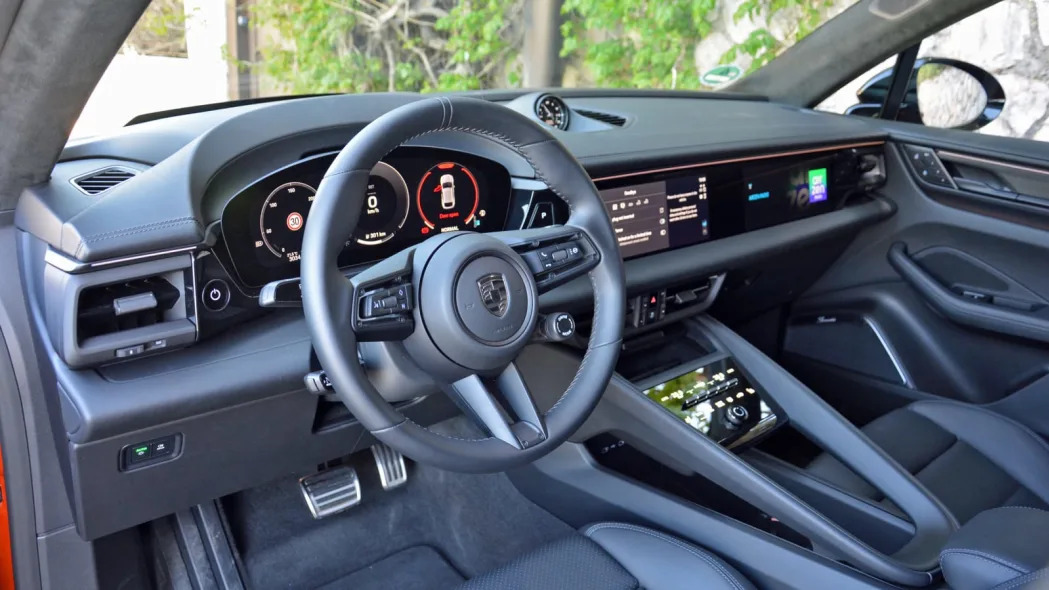
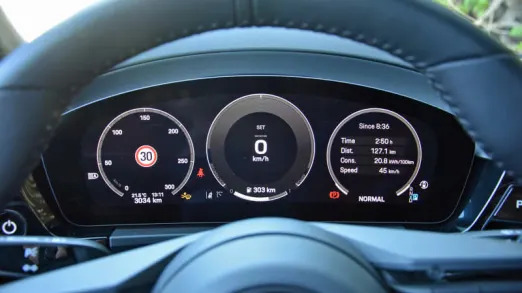
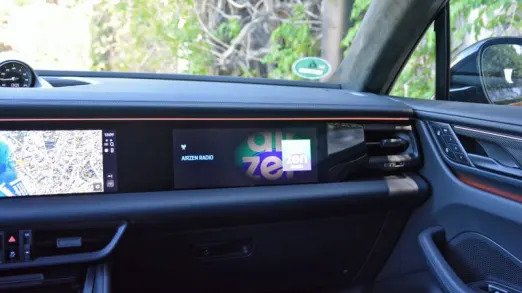
Power on the Macan, flick the shifter out of park, and you’re off in complete silence. You can enable a UFO-like acceleration noise via the main touchscreen, but without it, the cabin is remarkably quiet. That’s easier said than done in an EV, because the engine’s symphony isn’t there to cover up the various squeaks and rattles. Acceleration is smooth and linear, and the 4 has plenty of power.
Every member of the Macan Electric range comes with an air suspension system on both axles, and my test car was equipped with the optional rear-wheel steering system. The old Macan (outgoing isn’t the right term here, since it’s still going) isn’t available with either. The air suspension system does a good job of evening out bumps in the road and keeping body roll in check during cornering, but it’s the four-wheel steering that really works wonders. It helps the Macan take a bend like a smaller car by turning the rear wheels up to 5 degrees in the opposite direction of the front wheels at lower speeds. You can feel it and you can see it. It’s not tech for the sake of tech; it makes a big difference.
This handling capability is ultimately what sets the Macan apart, because in terms of acceleration it drives like any of the other EVs that boast the kind of horsepower you’d have expected from a supercar 15 years ago. Perhaps this is a question of habit or preference, but when driven spiritedly (which it really should be from time to time; it’s a Porsche, after all) it’s not quite as exciting as the original model.
While the “4” stands for “four driven wheels,” the Macan 4 isn’t always all-wheel-drive. It’s mostly rear-wheel-drive, because the front axle is usually in sleep mode to save energy. It joins the party “when extra stability is needed or under heavy acceleration,” Meier told me. This happens behind the scenes. From behind the wheel, you can’t tell whether the front axle is zapping the front wheels.

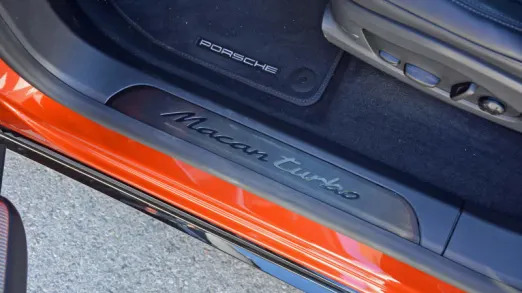
My first impression of the Macan Turbo is that it’s overkill. Not in a bad way; it’s the exact opposite. It’s overkill in the same way that a 911 Turbo is overkill compared to, say, a 911 GTS. There’s no need to have this much power under your right foot, but, damn, it’s a lot of fun and you’re glad it’s there. The power gap that separates the Turbo from the 4 comes from a bigger motor on the rear axle. It’s mounted a little further back than the 4’s motor to shift the front-rear weight distribution from 50-50 to 48-52. The 2% difference isn’t perceptible, but the trim-specific torque vectoring system helps the Turbo pivot around a turn with more precision than a heavy SUV has any right to show off.
One advantage of electric drivetrains is the instant torque, and when you’ve got this much of it to play with (remember: 811 pound-feet!) it’s almost brutal. Mash the accelerator pedal and you might as well be on the downhill part of a high-speed ride at an amusement park. It keeps going, and going … and going. There’s no lag and no interruption in the power flow. It embarrasses sports cars.
Mash the other pedal, and the Turbo stops almost as quickly as it accelerates thanks in part to six-piston front calipers (the 4 ships with four-piston front calipers). The brake pedal is a nice surprise: It doesn’t feel like a button on a Nintendo 64 controller, which is the case in many EVs and plug-in hybrid models. And yet, there’s up to 240 kilowatts of regeneration quietly slowing down the Macan.
“More than 90% of the time, when you push the brake pedal you only brake by regen,” Meier explained. “There’s no friction braking. The brakes only come into play when you really push it extremely hard. Even in ABS situations, we still use as much regen as possible before using the friction brakes.”
You don’t feel the regen while driving; the Macan coasts when you lift your foot off the accelerator. You can dial in a little bit of regen resistance by flicking a digital switch found in one of the touchscreen’s “settings” menus, but one-pedal driving, where you almost never need to step on the brake pedal, isn’t possible. Want to slow down? That’s what the brake pedal is for, Porsche argues.
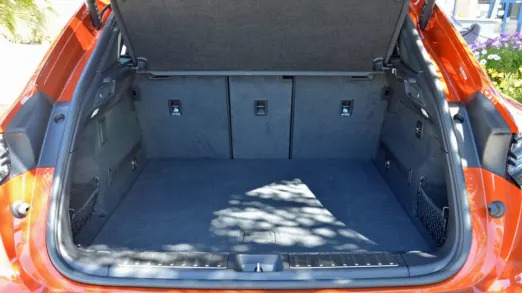
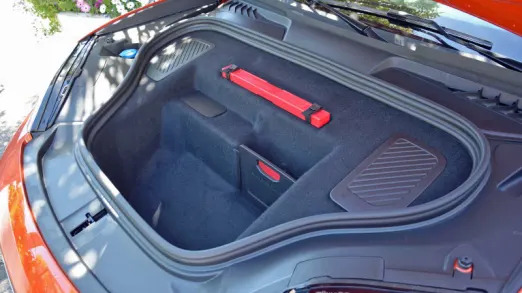
One issue with the new Macan is visibility. The thick A-pillars block the driver’s view on either side, and the field of view out of the rear window is small. It gets even smaller when the speed-activated rear spoiler pops up. The new Macan would be a good candidate for a camera-based mirror system.
The trade-off of that visibility and the tapered rear end that causes it is a 0.25 drag coefficient, so the new Macan is considerably more aerodynamic than its predecessor, which had a 0.35 drag coefficient. Less wind resistance equals more range; Meier said his team’s simulations suggest that the Macan would lose about 52 miles of driving range if it had the original Macan’s drag coefficient. It rides on a longer wheelbase that clears up more interior space, and it benefits from more trunk space even before the frunk enters the equation. Porsche achieved this without super-sizing its smallest crossover. The new model stretches about 188 inches long, 76 inches wide, and 64 inches tall, so its footprint is almost exactly the same size as the first Macan’s.
Beauty is in the eye of the beholder, or realistically in the eye of the dude signing the check, so I’m not here to tell you whether or not the new Macan looks good. One interesting detail worth pointing out is that the lights located in the middle of the hood-bumper-fender junction aren’t the headlights; they’re the daytime running lights. The headlights are lower and integrated into the bumper.
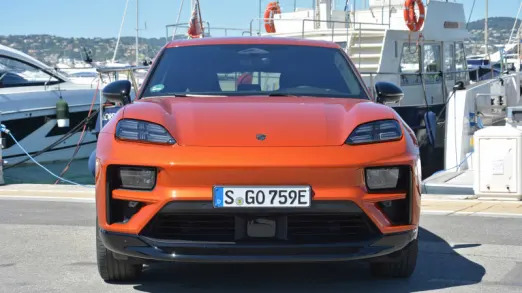

Pricing for the 2024 Macan 4 starts at $78,800 not counting destination, which hasn’t been published yet, and the Turbo model carries a base price of $105,300. That’s one of the more unfortunate side effects of going electric: You get a Macan that costs as much as a Cayenne. The base 2024 Cayenne starts at $80,850 including a $1,650 destination charge, and the base last-gen Macan costs $64,895.
At least both models are relatively well equipped. The entry-level 4 comes standard with an air suspension system, 20-inch wheels, a panoramic roof, a heated steering wheel, and adaptive cruise control. Get the Turbo and the list of standard features grows with trim-specific accents inside and out, LED Matrix-design headlights, carbon fiber interior trim, 18-way power-adjustable adaptive front sport seats, a surround-view camera, and a Bose surround-sound system. Options include a head-up display, a rear-wheel steering system, and the passenger touchscreen
Porsche’s rare instances of revolutionary changes have always been met with skepticism from a slice of its customer base – look up “996-generation 911” for an example. Making the new Macan electric will spark similar debates. It’s a great SUV, but it wouldn’t be any worse with a V6 instead of a frunk.
Electrification might alienate some buyers, but it should also lure new customers into Porsche stores, and the Macan has always been a conquest model. Meanwhile, drivers who want a Macan but don’t want an EV will settle for the old one. Grab the popcorn: This will be an interesting duel to watch.

